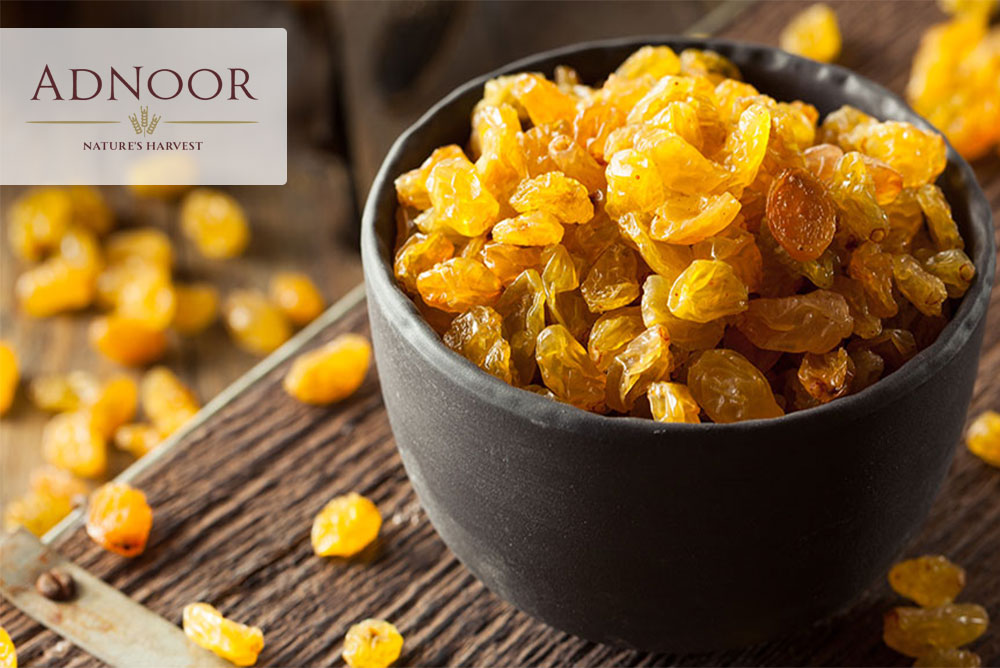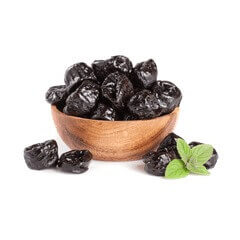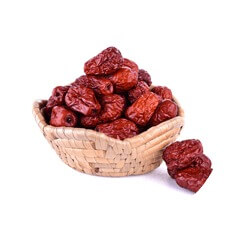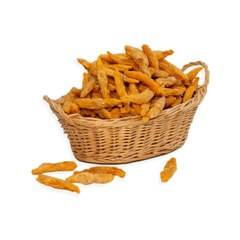Consumed as a snack or incorporated into pastries, rice cakes or semolina, or even in aperitif mixes, raisins are small nuggets of nutritional benefits.
This sweet little nugget that the taste buds love is grown all over the world, but it is only in a few places that raisins are best produced. It is necessary to have a favourable environment for the grapes to dry subtly.
What Are Raisins?
Raisins, also known as “sultanas,” are a variety of seedless grapes that are bred to dry. Its taste is very sweet, thanks to the amount of sugar contained in each grain. It is particularly appreciated as an ingredient for confectionery products.
It is possible to have different varieties of raisins; the most common is the sultana, with smaller grains than the others and very sweet, yellow with golden nuances. Other popular varieties are:
- The Malaga grape is very large and light, with few seeds.
- The Izmir grape is also large, dark and seedless.
- The Corinth grape is of oriental origin, small, seedless and blue in colour.
How to Use Raisins in Cooking and Baking?
Raisins are macerated in lukewarm water, wine or rum and are used to stuff yeast dough (raisin bread), enhance rice or semolina entremets, and enrich puddings and cakes. Drizzled with lemon juice or rum, they pleasantly flavour fruit salads.
In the kitchen, raisins are mainly used as an ingredient for cakes or savoury timbale. It is mainly found in cookies, strudels or as an ornament for sweet bread. Among the best-known recipes with grapes, we cannot fail to mention the grape product par excellence, namely Panettone. But small grains are also part of other very special dishes, including many savoury dishes. Salted cod in Campania, for example, or Sicilian stockfish and sardine dish in Veneto.
In Short:
From the dried fruit family, raisins are a natural source of energy. The advantage of raisins is their year-round availability and ease of storage. Contrary to popular belief, raisins turn out to be an ally in a diet.
Virtues:
- Source of energy, raisins are much higher in calories than fresh grapes
- Rich in trace elements, including calcium, iron, potassium and magnesium
- Against osteoporosis: Raisins are rich in boron, a trace element that promotes bone health
- Source of antioxidants: raisins contain many polyphenols that protect the heart and slow down cell aging
- Interesting for athletes: Raisins have an energizing power and are rich in vitamins and carbohydrates, which makes them perfect before and during exercise to improve performance
- It helps relieve constipation due to its high fructose content and laxative properties
Use:
30g per day in 2 doses for a healthy adult.
For their culinary use, the raisin can be cooked without problem. To soften them, you can first soak the raisins in a liquid: hot water, flavoured tea, or fruit juice.
Precautions for Use:
Contraindicated in people with diabetes mellitus (types 1 and 2), obesity, gastric ulcer, gallstones, enterocolitis, mouth ulcers, cardiovascular failure, tuberculosis and digestive problems and known allergy to grapes.
Raisins Varieties
The varieties of grapes chosen to make raisins have this in common their grains do not contain seeds: currants, Smyrna, Muscat of Alexandria and Thompson Seedless (for blond and golden grapes).
How to Get the Raisin?
The bunches of grapes undergo different treatments depending on the region and the method of production. In China, in the Turfan valley, the bunches of grapes are hung in dryers and undergo desiccation by the desert wind; in Malaga, the grapes are dried in the sun; the industrial method consists of immersing the grapes in very hot water before passing them through a dehydration tunnel.
What Are The Benefits Of Raisins?
Although raisins are quite high in calories and therefore not very suitable for the diet of overweight people, they are perfect for a healthy and energizing snack. Raisins, like prunes, help a lot with intestinal problems and constipation and aid digestion. Among the other beneficial properties of raisins for our body, remember that they help prevent cavities, thanks to oleanolic acid. Raisins protect eyesight and the body against infections, prevent cancer, strengthen bones and help with anemia.
Raisins are rich in fibre and mineral salts such as potassium, iron and calcium.
Raisins Are A Concentration Of Energy.
Did you know that raisins are actually dehydrated fresh grapes? This makes them a great option for long-term preservation. Raisins contain only about 25% water, compared to fresh grapes, which are 80% water. This low water content means that raisins are packed with energy, containing 275 calories per 100g, which is five times more than fresh grapes. Raisins are high in carbohydrates, specifically fructose, glucose, and sucrose, making up around 70% of their content.
Raisins are perfect for a quick energy boost, especially during physical activities. They are even comparable to nutritional supplements for athletes but much more delicious! However, it’s important to keep in mind that their glycemic index is high, meaning they can increase insulin secretion. In order to avoid any negative effects, it’s best not to consume them in isolation or overindulge too frequently. Additionally, while raisins are originally devoid of lipids, they are often coated in oils like sunflower or palm oil, partially hydrogenated to enhance their shine and taste and extend their shelf life.
Dehydrated Grapes Are Revitalizing!
Raisins are indeed essential as invigorating. Being dehydrated, they are not only highly energetic but also great reservoirs of vitamins and minerals.
Side vitamins, those of group B are needed in force. Raisins are essential for the metabolism of sugars and are perfect for athletes. On the other hand, do not count on vitamin C; there is none. Indeed, the dehydration treatment got the better of her!
As for minerals and trace elements, the list is interesting. Potassium, calcium and magnesium are essential to avoid muscle cramps. As well as the iron-copper duo, a cocktail of antioxidants that it would be a shame not to consume because it delays the onset of muscle fatigue and, above all, allows you to recover better.
An Ideal Source of Fibre against Constipation
Fibre is part of carbohydrates, but carbohydrates that the body cannot digest or assimilate. They are essential for good regulation of intestinal transit and play a role in satiety. And those raisins have the particularity of being sweet, therefore ideal in case of constipation. Count on a content of 3 to 4%, which is far from negligible.
A contribution of fibres practical to transport and consume. This is a major asset. Think of this little grain of fantasy!
Let’s Talk About Currants.
Red, black or white, the gooseberry is an ancient variety of berries: small juicy spheres with an inimitable pungent taste, known and appreciated for their excellent beneficial and medicinal properties. Here is the nutritional profile and benefits of currants with some ideas for using them in cooking.
What Are Currants?
Currant is the fruit of the gooseberry, a plant belonging to the Grossulariaceae family, a medium-sized shrub with small fruits gathered in clusters (from 5 to 20 berries), berries with a sweet flavour and juicy pulp. Currants have been known since Roman times for their strong beneficial properties, and appear on the market and supermarket shelves in late summer and can be enjoyed freshly picked in their natural state or in sweet and savoury recipes.
In nature, there are three varieties of currants: the red currant, the white currant and the black currant, varieties that differ in colour but are nutritionally similar in their taste, which is slightly acidic. Rich in minerals and vitamins, gooseberries are powerful natural antioxidants, have a diuretic and detoxifying effect and help protect our eyes and bones.
Currants Properties
Gooseberry is incredibly rich in beneficial properties: small in size but very interesting from a nutritional point of view. Composed of nearly 80% water, currants are definitely low in calories (only 28 kcal per 100 grams of fresh fruit) and rich in minerals, especially potassium, calcium and phosphorus.
Gooseberry skin contains a good amount of fibre, which is essential for bowel function and regularity. In contrast, the amounts of carbohydrates and protein are negligible, as is cholesterol, which is completely absent. Rich in citric acid, anthocyanins and flavonoids (especially the black variety), gooseberries are powerful antioxidants and contain vitamins C, A and B2.
The Benefits of Currants
Why include gooseberries in your diet? Like all berries, currants are fruits rich in beneficial properties, useful not only in case of stress and fatigue but also to protect our immune system and fight against cellular aging. In detail, these small fruits are:
- Purifying and diuretic: the composition of currants makes these berries useful for diuresis and the fight against cellulite and water retention, with a detoxifying and purifying effect;
- Allies of sight: currants have a refreshing and protective effect on the retina, which is valuable for the health of the eyes and sight;
- Thanks to vitamin C, currants have an antibacterial and anti-inflammatory effect;
- They stimulate concentration and memory thanks to the presence of mineral salts, in particular, potassium;
- Vitamin C helps, supports and strengthens the immune system, allowing us to fight against seasonal ailments and ailments;
- Currants are useful during pregnancy as they can prevent and relieve swelling and heaviness in the legs;
- Rich in anthocyanins and flavonoids, gooseberry is a powerful antioxidant that counteracts the action of free radicals and cellular aging;
- Currant leaves are used as an infusion to relieve rheumatic and arthritic pain;
- Gooseberries act in the process that triggers allergic reactions by reducing the production of histamine, the substance released in response to allergic stimuli;
- Mineral salts and vitamin K strengthen bone tissue and protect the skeletal system.
Kitchen Uses
Red, black or yellow currants are characterized by a sweet flavour and a pleasantly tart note, which make these small fruits good to eat in their natural state and ideal for preparing mouth-watering recipes. The area in which gooseberries are at their best is undoubtedly confectionery: for a fresh and effortless dessert, try gooseberry cheesecake, ideal for serving as a dessert or perhaps a peach and gooseberry pie, simple but healthy, grandma’s timeless recipe that never disappoints.
Gooseberries’ favourite field is, of course, baking, but experimentation is always interesting in the kitchen! Serve your guests a gazpacho of fragrant red berries, and they will be amazed. What if we told you that the gooseberry also gives a very sweet liqueur, used to prepare a Kir Royal, a refined and fragrant cocktail? Curious to try it? Take the leap!

Raisins: Your Slimming Ally
Rich in iron, calcium, potassium and magnesium, raisin is a fruit that contains a very interesting nutritional interest for people wishing to lose weight.
But beware, its calorie intake still requires it to be consumed in moderation, like a food that would satisfy this addictive craving for sweets during a slimming program.
Does Eating Raisins Make You Fat?
Raisins are an energy food that helps to overcome fatigue and diet-related crashes. It is also an appetite suppressant. The fresh grape is basically a fruit very rich in sugars, the raisin, which has therefore lost its water, has a sugar level 4 times higher! Likewise, the nutrients are four times more concentrated, such as boron which would help fight against osteoporosis. They are bombs packed with antioxidants, including polyphenols activated during dehydration, such as resveratrol which would be an ally against cancer. So interesting, but beware of the carbohydrate load that its consumption implies.
A scientific investigation has even shown that raisins can be an effective way to lose weight, especially to reduce abdominal fat.
In addition, it is an antioxidant fruit since it contains many phenols which help prevent cardiovascular diseases. Rich in vitamin B6 and fibre, raisins are also interesting in case of constipation.
Raisins Drawback
Relatively rich in carbohydrates, raisins must be consumed in a balanced way because they may produce an unexpected effect due to their high caloric content, 326 kcal per 100 grams.
In equal quantity, they are more caloric than fresh grapes. The raisin does not contain zero calories; therefore, it is fattening if consumed excessively. It is therefore advisable to limit the quantity!
How to Eat Raisins without Gaining Weight?
In view of the nutritional information on raisins, one may wonder when to eat them without gaining weight and whether one can lose weight quickly if they are eaten.
It is possible to add it in the morning to breakfast in your cottage cheese, for example, in a light cake or as a snack.
Alternatively, raisins can also be an ingredient in a low-calorie dessert recipe. Thus, it is possible to lose weight without depriving yourself. Now the answer is clear. Do raisins make you fat? We will answer no when it is consumed in moderation.
Adnoor is the ideal platform to get the best quality raisins, dried fruits, nuts, and basmati rice in Canada.









Raisins from Grapes to Delicious Treats - Adnoor
May 10, 2023[…] Raisins are a beloved snack for many Canadians and for good reason. These tiny treats are not only delicious and convenient, but they also pack a nutritional punch that makes them a smart choice for anyone looking to improve their diet. One of the biggest benefits of raisins is their high concentration of antioxidants. These powerful compounds help to protect our cells from damage caused by free radicals, which can contribute to a range of chronic health problems such as cancer, heart disease, and cognitive decline. In fact, studies have shown that raisins are one of the best natural sources of antioxidants, making them an excellent addition to any healthy diet. […]